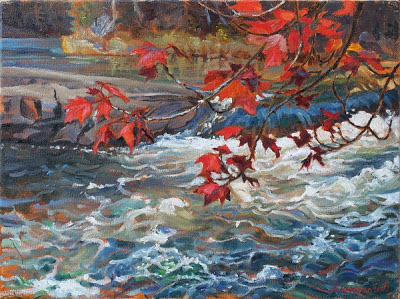Precious Wild Rivers (calendar for 2013)
Our 2013 calendar is published! "Precious Wild Rivers" is a collection of my oil paintings en plein air of rivers, rapids, and waterfalls in Ontario. This autumn Fred and I traveled to precious wild rivers that still run free with rapids and waterfalls, to paint and explore for little-known native mussels and crayfish, documenting these vulnerable wild communities in art and science. I've gathered all of these paintings as well as a few earlier ones, into a new calendar where the image of each painting is accompanied by journal of our adventures in discovering the special nature of that place, as well as the nature of the threats to its integrity, leading us to enquire whether new hydroelectric projects on our wild rivers are desirable or necessary. The calendar finishes with January 2014 and a full page essay by Fred.
Preview and purchase the calendars
50% of proceeds from the sale of these calendars supports rivers conservation by Ontario Rivers Alliance
50% of proceeds from the sale of these calendars supports rivers conservation by Ontario Rivers Alliance




here's a draft of the first half of the essay -
ReplyDeleteOne of the easiest things to do to a river is to dam it up for the sake of power, flood control, or water-taking; it seems that one of the hardest things to do is to remove a dam when it no longer serves its intended purpose but local People have gotten used to it. Rivers are ecological connections and migratory pathways, so a dam immediately breaks many previously continuous populations into segments, both by the physical barrier of the dam and any turbines, and by the imposition of a novel still-water habitat in the headpond.
Some species endure dams, and some can’t. Impoundments are often biological deserts, both because they're neither lake nor stream, and because freshwater species don't have the adaptations to water level fluctuations that billions of years of tidal activity have evolved in marine life. Even species that aren’t usually thought of as migratory may be limited by dams: we’ve found that Mudpuppies aren’t found upstream of the lowermost dams or weirs on the tributaries of the Rideau River. If a species can’t live in an impoundment or in a Zebra Mussel-infested mainstream, those individuals which happened to live in tributaries suddenly become genetically precarious population fragments, rather than outliers of large interbreeding regional populations.
Fishways can mitigate the passage of the conspicuously migratory species, though these are so rarely mandated in Ontario that we don't know much about how to build them or how well they work, but they don't remedy the fragmentation of habitat, or the movement of less conspicuous species.
High Energy Sites: Because of the speed and pulsing of the water, the communities that assemble within chutes, falls, and rapids are different from those in calmer waters elsewhere along a stream. These sites are specially targeted for elimination by damming, because they only occur at the kind of places where dams would be put. Their beauty, biotic importance, and hydroelectric potential are all consequences of the high energy of the falling water....
The big fact about high energy sites in Ontario is that lots of them were taken out by the mill dams and industrial waterpower dams of the 19th Century, and then many more were taken out by the hydroelectric dams of the early and mid- 20th Century, so that when we're considering the fate of the remaining sites they've got to be thought of as “communities at risk” - a small remaining fraction of the high energy sites that were present before settlement.
ReplyDeleteThe importance of such sites in each region, or along each river, is properly assessed on a landscape- and drainage basin-wide scale. The highest-energy sites are already submerged by existing hydro dams or canals which were put in decades or centuries ago, so that the big rivers are already deprived of most of their falls and chutes and rapids. The calculus of evaluating any new sites should be cast in terms of the percentage of high-energy sites they represent, both of surviving sites, and of the pre-settlement original total. To say that proposed hydro development removes 50% of the high-energy sites from a drainage basin or region is different from saying that it would remove 50% of the remaining 15% of the original high energy sites.
In Ontario, their have been two previous generations of dam building: the mill dams and industrial water power facilities of the 19th Century which contributed to the extinction of the Lake Ontario Salmon and the general diminishment of Sturgeon, and the hydro dams of the 20th Century which expanded these effects into the wilderness, and took out the Eels and the freshwater mussels along hundreds of kilometres of the bigger rivers.
Damming Ontario streams has always been accompanied by political shenanigans and hijinks, which have repeatedly resulted in many facilities which, in addition to the ecological damage they have caused, have had doubtful social utility, while delivering gratuitous fiscal profits to the promoters of the schemes. We're so used to these older structures now that we think of them as permanent features of the landscape, but a “heritage feature” is not a natural phenomenon, but is “a mistake, made by your ancestors, that you've gotten used to.”
Our recent visits to waterfalls and chutes were inspired by the threat of a third generation of damming, again accompanied by political shenanigans and hijinks, which promise to deliver ecological damage and doubtful social utility, while providing gratuitous fiscal profits to the promoters of the schemes. By these visits, we hope to document both the beauty of the sites, and the unstudied populations of big invertebrates, freshwater mussels and Crayfish, which make up so much of the life in these rivers.